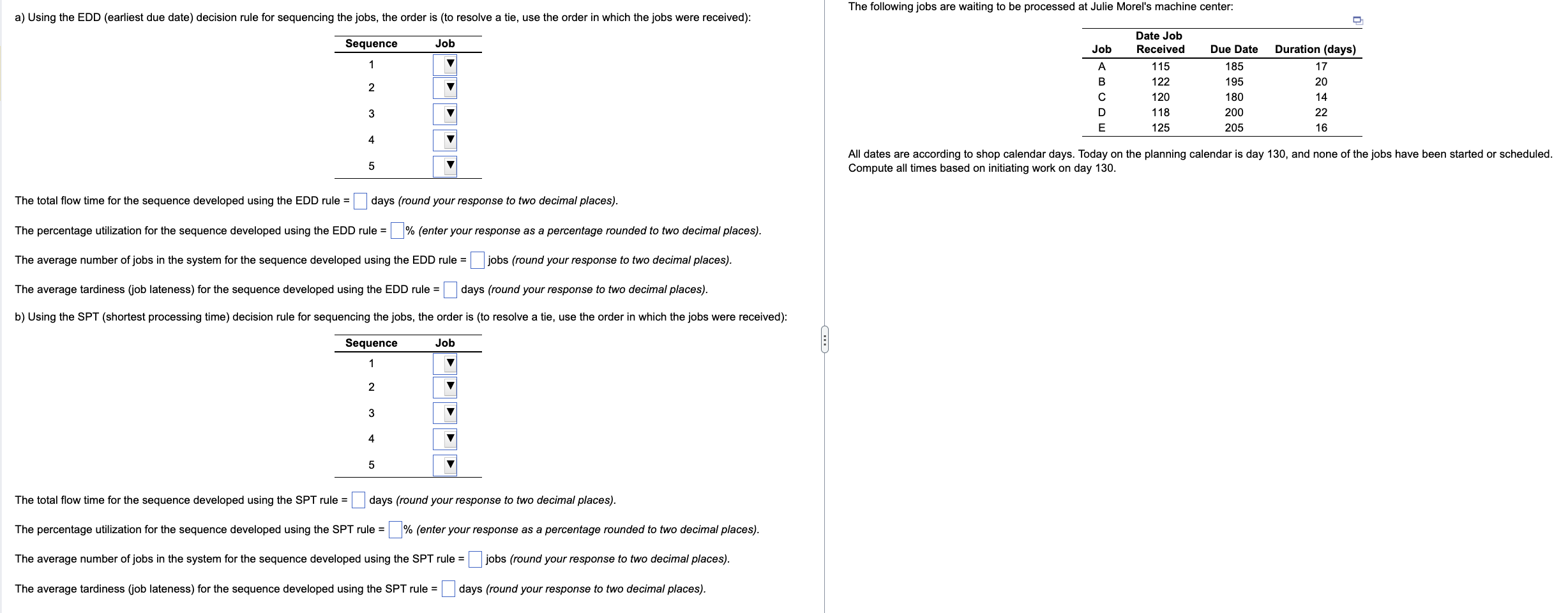Question
Part 1 a) Using the EDD (earliest due date) decision rule for sequencing the jobs, the order is (to resolve a tie, use the order
Part 1 a) Using the EDD (earliest due date) decision rule for sequencing the jobs, the order is (to resolve a tie, use the order in which the jobs were received): Sequence Job 1 E C A B D 2 A C D B E 3 E D A C B 4 D B C A E 5 B D C A E The total flow time for the sequence developed using the EDD rule =(round your response to two decimal places). The percentage utilization for the sequence developed using the EDD rule = (enter your response as a percentage rounded to two decimal places). The average number of jobs in the system for the sequence developed using the EDD rule = jobs (round your response to two decimal places). The average tardiness (job lateness) for the sequence developed using the EDD rule = days (round your response to two decimal places). b) Using the SPT (shortest processing time) decision rule for sequencing the jobs, the order is (to resolve a tie, use the order in which the jobs were received): Sequence J
 All dates are according to shop calendar days. Today on the planning calendar is day 130, and none of the jobs have been started or scheduled. The total flow time for the sequence developed using the EDD rule = days (round your response to two decimal places). The percentage utilization for the sequence developed using the EDD rule =% (enter your response as a percentage rounded to two decimal places). The average number of jobs in the system for the sequence developed using the EDD rule = jobs (round your response to two decimal places). The average tardiness (job lateness) for the sequence developed using the EDD rule = days (round your response to two decimal places). b) Using the SPT (shortest processing time) decision rule for sequencing the jobs, the order is (to resolve a tie, use the order in which the jobs were received): The total flow time for the sequence developed using the SPT rule = days (round your response to two decimal places). The percentage utilization for the sequence developed using the SPT rule = o (enter your response as a percentage rounded to two decimal places). The average number of jobs in the system for the sequence developed using the SPT rule = jobs (round your response to two decimal places). The average tardiness (job lateness) for the sequence developed using the SPT rule = ays (round your response to two decimal places)
All dates are according to shop calendar days. Today on the planning calendar is day 130, and none of the jobs have been started or scheduled. The total flow time for the sequence developed using the EDD rule = days (round your response to two decimal places). The percentage utilization for the sequence developed using the EDD rule =% (enter your response as a percentage rounded to two decimal places). The average number of jobs in the system for the sequence developed using the EDD rule = jobs (round your response to two decimal places). The average tardiness (job lateness) for the sequence developed using the EDD rule = days (round your response to two decimal places). b) Using the SPT (shortest processing time) decision rule for sequencing the jobs, the order is (to resolve a tie, use the order in which the jobs were received): The total flow time for the sequence developed using the SPT rule = days (round your response to two decimal places). The percentage utilization for the sequence developed using the SPT rule = o (enter your response as a percentage rounded to two decimal places). The average number of jobs in the system for the sequence developed using the SPT rule = jobs (round your response to two decimal places). The average tardiness (job lateness) for the sequence developed using the SPT rule = ays (round your response to two decimal places) Step by Step Solution
There are 3 Steps involved in it
Step: 1

Get Instant Access to Expert-Tailored Solutions
See step-by-step solutions with expert insights and AI powered tools for academic success
Step: 2

Step: 3

Ace Your Homework with AI
Get the answers you need in no time with our AI-driven, step-by-step assistance
Get Started


